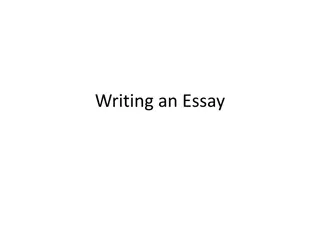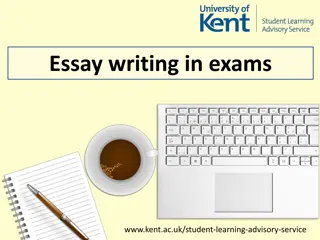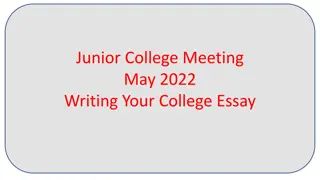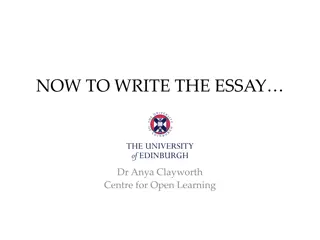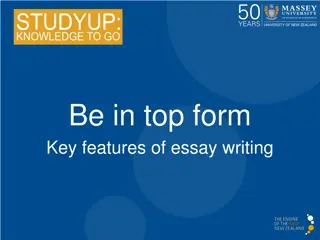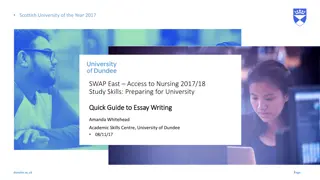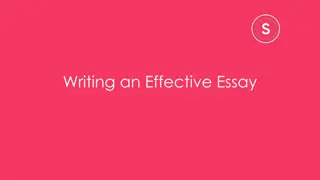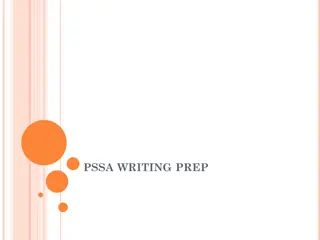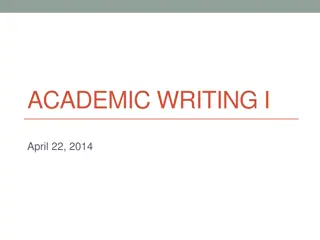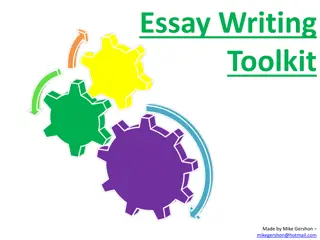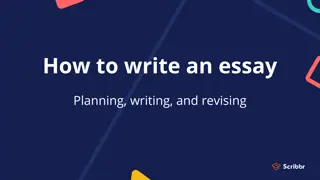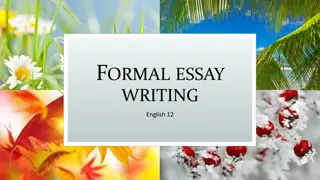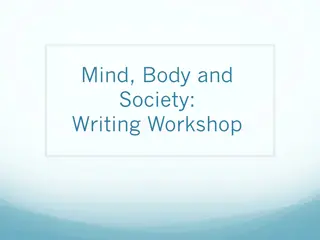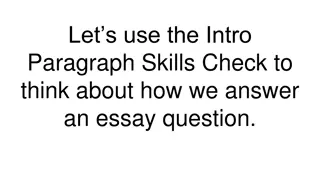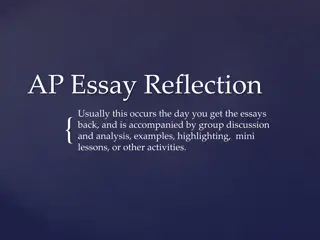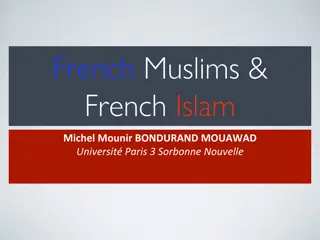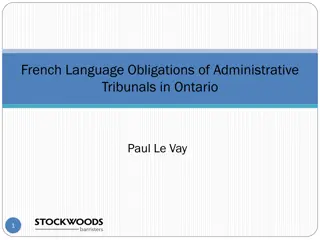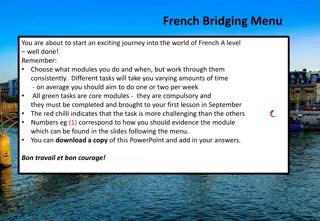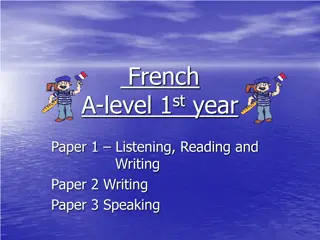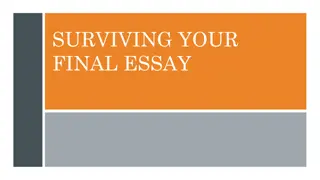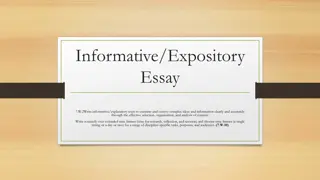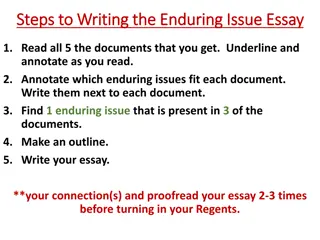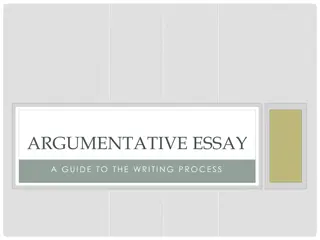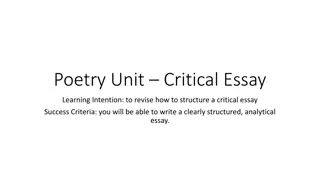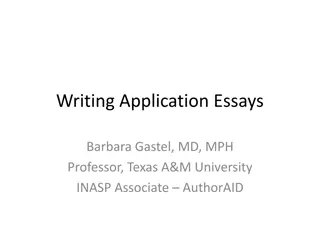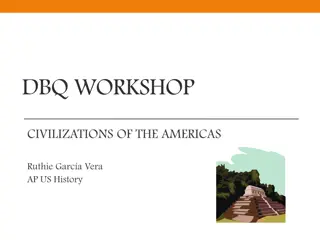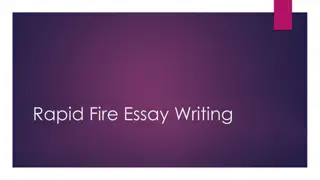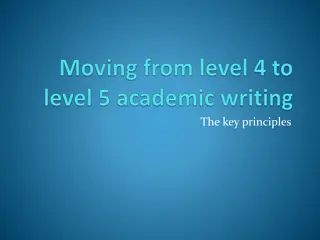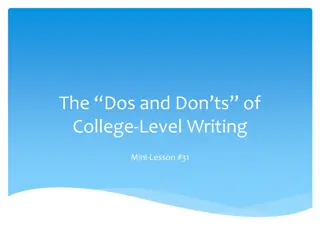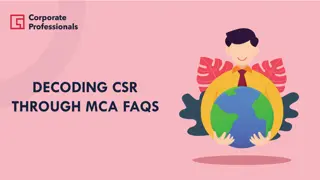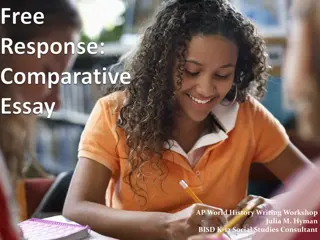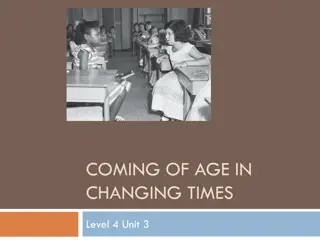French Essay Writing Guidelines and FAQs
Learn about the components of an essay, tips to avoid common mistakes, sample essay questions, and preliminary steps for analyzing essay prompts in French language studies.
Download Presentation

Please find below an Image/Link to download the presentation.
The content on the website is provided AS IS for your information and personal use only. It may not be sold, licensed, or shared on other websites without obtaining consent from the author. Download presentation by click this link. If you encounter any issues during the download, it is possible that the publisher has removed the file from their server.
E N D
Presentation Transcript
Essay Writing Guidelines and FAQ Department of French
What is an essay? A piece of prose writing discussing a specific topic; producing an organized, coherent argument based on a plan; expressing an original/individual viewpoint on the topic under discussion.
Things to avoid: Being off subject i.e. discussing a topic not related to the one proposed by the essay question. Writing a chaotic essay i.e. a piece of writing in which the elements of your argument are not logically linked (1) to each other or (2) to the topic. Engage in plagiarism i.e. using someone s ideas, words, or texts, without duly acknowledging them and therefore implying said ideas are your own.
Sample essay question Beckett est essentiellement tragique (Eug ne Ionesco). Discuss this comment, with reference to En attendant Godot.
Preliminaries Consider the wording of the title carefully. Look up terms which are unclear. Consider the structure of the question: Quotation (Ionesco) + Question (discussion + specifies the work to be discussed: En attendant Godot).
Analysis of the quotation: Beckett est essentiellement tragique (Eug ne Ionesco). Try to situate the quotation: find out more about its author In this case: the French-Romanian playwright Eug ne Ionesco, a contemporary of Beckett s. A statement: ask yourself whether you agree or not. Analyse the structure: Beckett : reflects the general nature of the statement not a specific work by Beckett, but his work as a whole; est essentiellement : there may be room for other elements (comic, for instance); tragique : the term is being used is its generic, dramatic sense.
Analysis of the question: Discuss this comment, with reference to En attendant Godot Discuss this comment : It s an open question; It does not suggest a specific structure (as do, for instance, the expressions: compare and contrast ; do you agree ? ; to what extent ); Possible ways to structure your essay: Conform to the statement: Godot is essentially tragic because Disagree with it: Godot is not essentially tragic because Offer a dialectical response: On the one hand, yes on the other hand, no in conclusion with reference to En attendant Godot : Need to focus on this particular play (citing specific passages); Address the text in full (Act 1 and Act 2).
Before planning your essay Re-read the work As you re-read, focus on the issues raised by the essay title. Take notes Earmark possible quotations (i.e. your primary sources) to illustrate points later. Sources Use relevant secondary sources (when available) to back up your claims. Always clearly acknowledge your sources in the text of your essay (footnotes).
Essay Plan Organising your argument Introduction Conclusion Tips
Organising your argument Draw up a plan that identifies the main points you will discuss: You will need to explain /develop each point and illustrate them with a reference / quotation: A primary source (En attendant Godot); A relevant secondary source (where available): Another play by Beckett; Literary criticism on the play or on Beckett (e.g. Michael Worton, Martin Esslin, etc.); Drama more generally (for instance, texts quoted in the Critical Texts Anthology: Aristotle, Moli re, Voltaire, Artaud, Ionesco, etc.).
Organising your argument (cont d) You will have room for 3 or 4 main points in the essay: Establish priorities and be selective; Refer only to material that is relevant. A plan will help you with presenting your case concisely and persuasively. Most important aspect of an essay: produce a rigorous and coherent argument. Order your points to follow on logically from one another: Each paragraph should deal with a single idea.
Introduction Demonstrate that you have understood the question: For instance, begin with a brief analysis of the topic/question. Demonstrate how you have understood the question: In this case, acknowledge the generic stakes of the question. Outline briefly in a tentative way (i.e. raising questions): What the stakes are; what the issues are; What your argument will consist in; How your claims will be made: You agree with Ionesco s statement. You disagree with Ionesco s statement. The status of genre in Beckett cannot be decided in the terms of Ionesco s statement. Briefly announce the plan of the essay.
Conclusion Briefly summarise the points made. Clearly reflect the stakes / issues set out in the introduction: Do not simply repeat the introduction. State the conclusions reached through your analysis (at this stage, you may adopt a more assertive tone). Open up the discussion: Indicate relevant questions / issues your explorations have thrown up. Indicate where you might logically go from here (if you had more time and space).
Tips Make sure you are answering the question, avoiding being off topic. Always back up your claims with evidence, using relevant primary and (where available) secondary sources. Avoid being too personal in your expression ( I feel/think that this play is about , reading the play, I felt/thought that , etc.). Be analytical:avoid describing the text (remember: your reader already knows the text). Always ask not just What does the author say? but How? and Why? .
Tips (contd) Where possible and relevant, introduce different viewpoints and show how your own viewpoint can be defended against others. Help your reader: as you finish one point or embark on a new one, you may sum up briefly what it has brought to your argument and where the discussion is going next. Always proofread your essay when you are done, making sure that the essay is free of any grammatical mistakes or infelicities. Do not forget to add a short bibliography at the end of your essay, listing your sources (primary and secondary), in alphabetical order.
Presentation of Written Work Layout: Word-processed, font (Arial or Times New Roman) size 12; Double-spaced; Each paragraph indented one inch from the margin. Quotations: Place quotations in inverted commas ( or ); All quotations from poetry or verse drama and those over four lines long from prose should be started on a new line and indented (i.e. set in an inch from the margin). Citations: Indicate the precise source of the quotation in a footnote (following footnoting format given below); At first citation give full bibliographical details; at subsequent mention please quote only author name and work title followed by page number of quotation. Bibliography: List all works consulted (primary and secondary sources); Place texts in alphabetical order of author s last name.
Citations Books: Author, title, place of publication, publisher, date of publication + page number(s) of quotation: e.g. Jean-Paul Sartre, Qu est-ce que la litt rature? (Paris: Gallimard, 1948), p. 16. Articles: Author, title, journal (volume, number), date, page range + page number(s) of quotation: e.g. Michael Holquist, Nonsense and Modernism , Yale French Studies, 96 (1999), 100 17 (pp. 100 01).
Chapter in book: Author, title, name of editor(s), book title, place of publication, publisher, date, chapter, page range + page number(s) of quotation: e.g. Roman Jakobson, On Linguistic Aspects of Translation , In L. Venuti (ed.), The Translation Studies Reader (New York: Routledge, 2000), chap. 8, pp. 113 18 (p. 115). Online Journal Articles and Databases: Author, title, journal, date, web address, date of access: E.g. Kent Bach, Performatives , in Routledge Encyclopedia of Philosophy (2001),http://www.rep.routledge.com [accessed 10 December 2012].
Bibliography Same referencing system as footnotes, BUT reverse author s last and first name: e.g. Sartre, Jean-Paul, Qu est-ce que la litt rature? (Paris: Gallimard, 1948).
Notes Most of the information used above is taken from the JF Guidelines to Essay and Commentary Writing which is available on Blackboard at: http://mymodule.tcd.ie You can find past exam papers at the following address: http://www.tcd.ie/Local/Exam_Papers/index.html Searching for secondary sources: TCD Library The following electronic databases (access through Library website under Databases and Ebooks ): Jstor: http://stella.catalogue.tcd.ie/iii/encore/record/C__Rb12703766?lang=eng Project MUSE: http://stella.catalogue.tcd.ie/iii/encore/record/C__Rb13094028?lang=eng MLA International Bibliography: http://stella.catalogue.tcd.ie/iii/encore/record/C__Rb12703777?lang=eng
Examples of Secondary Sources on JF Texts Studied Beckett Esslin, Martin, The Theater of the Absurd (New York: Vintage Books, 2004). Worton, Michael, Waiting for Godot and Endgame: Theatre as Text in John Pilling (ed.) The Cambridge Companion to Beckett (Cambridge: Cambridge University Press, 1994), Ch. 4, pp. 67 87. Reza Carroll, No l, Friendship and Yasmina Reza s Art , Philosophy and Literature, 26.1 (April 2012), 199 206. Hellerstein, Nina, Entretien avec Yasmina Reza , The French Review, 75.5 (April 2002), 944 54. Resnais Caruth, Kathy, Literature and the Enactment of Memory in Unclaimed Experience: Trauma, Narrative, History (Baltimore and London: The Johns Hopkins University Press, 1996), Ch. 2, pp. 25 56. Monaco, James, Alain Resnais (Oxford / New York: Oxford University Press, 1979). Kassovitz Higbee, Will, Mathieu Kassovitz (Manchester: Manchester University Press, 2006). Vincendeau, Ginette, La Haine (London: I.B. Taurus, 2005).


